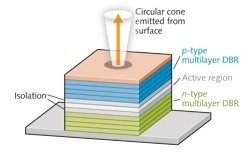The Volume Bragg Grating Lasers We Offer:

Wide Wavelength Range Red to SWIR with High Spectral Purity
-
- Wavelengths in the Red, IR, & SWIR (from ≈633nm to 1064nm) spectral regions
- Eliminates wavelength drift and provides exceptionally high spectral purity
- Multiple output power options available for most wavelengths

Innovative Technology with Narrow Linewidth Output
-
- VBG structure achieves narrow linewidth and consistent wavelength output
- Effective wavelength control even with changing temperature & aging
- High-quality output w/ low noise, driven by VBG technology

Customizable, Compact Designs for Sensing and Telecom Applications
-
- Available in TO-can, butterfly & other fiber-coupled component & OEM packages
- Compact, lightweight & robust designs support handheld/portable applications
- Hermetically sealed packages & optional fiber coupling ensure long-term reliability and ease of integration
For nearly 30 years, RPMC’s selection of Volume Bragg Grating Lasers has set the standard for affordable precision across a wide range of applications, from defense to medical, industrial, and research with 1000’s of successful units in the field. We understand that every application has unique requirements, which is why our configurable platforms are designed to offer the perfect fit for your needs. As your partner, we’re here to guide you through the selection process, ensuring that your VBG laser integrates seamlessly into your existing systems. With time-tested technology that balances power and precision, we’re committed to supporting your success every step of the way.
| Picture | Part Number | Wavelength (nm) | Description | Type |
|---|---|---|---|---|

|
RPK-IR-STAB | 785, 808, 878, 976, 1064 | Laser Diode, Wavelength Stabilized, Fiber-coupled, Infrared, 760-1400nm, up to 430W | Multi-Emitter, VBG, Narrow Linewidth, Single Longitudinal Mode (SLM), Fiber-Coupled |

|
RVBG | 633, 680, 785, 808, 860, 976, 1030, 1064 | Laser Diode, Stabilized, 633-1064nm, up to 600mW | LD Module, Single Emitter, VBG, Narrow Linewidth, Single Longitudinal Mode (SLM), Fiber-Coupled, Made in the USA |

 SHIPS TODAY
SHIPS TODAY 

